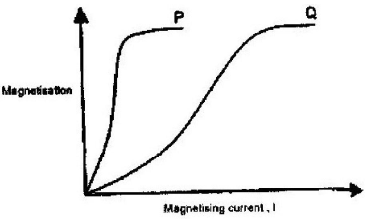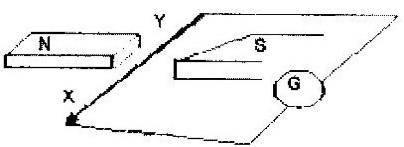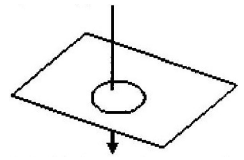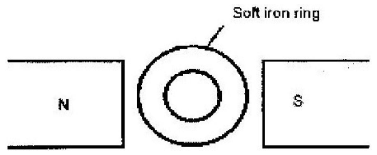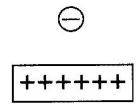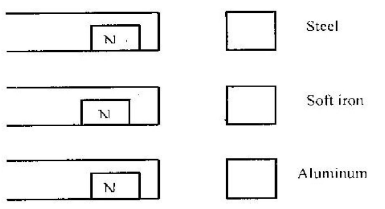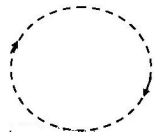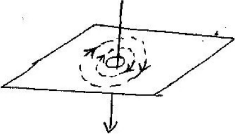Questions
- The graph in the figure below shows the relationship between the attractive forces of an electromagnetic and the magnetizing current. Give reasons for the shape of the curve in terms of the domain theory.
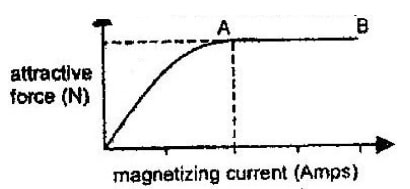
- The figure shows a wire in a magnetic field. A current is switched on to flow through the wire in the direction shown. State the direction of motion of the wire.
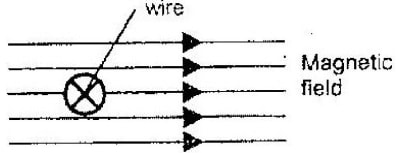
- The diagram in the figure below shows a flexible wire in a magnetic field.
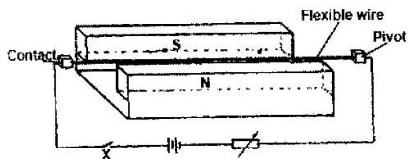
- Explain the behaviour of the wire when the switch K is turned on
- What is the behaviour of the wire if R is reduced?
- You are provided with two iron bars, X and Y, one is magnetized and the other is not. Explain how you would identify the magnetized bar without using a magnet.
- One way of demagnetizing bar is to place it in a solenoid in which an alternating current (ac) flows. How is the demagnetization achieved?
- Give two reasons why soft irons is used as a core of the coil of an electric bell.
- Give two differences between uniform and non-uniform magnetic fields
- The figure below represents a long horizontal insulated wire AB connected to an electric circuit. A plotting compass is placed on the wire as shown. When the switch K is closed, the plotting compass shows a deflection. State two changes which can be made in the circuit to increase the deflection.
- State three factors which determine the magnitude of the force on a current carrying conductor which is in a magnetic field.
- Give a reason why attraction in magnetism is not regarded as a reliable method of testing
- The figure below shows two parallel current- carrying conductors A and B placed close to each other. The direction of the current is into the plane of the paper. Copy the diagram and on the same figure;
- Sketch the magnetic field pattern
- indicate the force F due to the current on each conductor
-
- Given a bar magnet, an iron bar and a string.
- Describe a simple experience to distinguish between the magnet and the iron bar
- State with reasons the observations that would be made in the experiment.
- In an experiment to magnetize two substances P and Q using electric currents, two curves (graphs) were obtained as shown. Using the information in the figure below explain the differences between the substance P and Q with reference to the domain theory.
- Given a bar magnet, an iron bar and a string.
- Distinguish between soft and hard magnetic material
- Explain how hammering demagnetizes a magnet.
- How can it be shown that the strength of a magnet is concentrated at the poles
- The figure below shows a wire XY at right angles to a magnetic field. XY is part of a circuit containing a galvanometer. When XY is moved, the current flows in the direction shown. State the direction in which XY is moved
- The figure below shows how magnets are stored in pairs with keepers at the end. Explain how this method of storing helps in retaining magnetism longer. (2 marks)
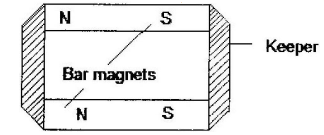
- In the figure below, the arrow indicates the direction of the current in the conductor. Sketch on the diagram the magnetic field pattern (1)
- The figure below shows a soft iron ring placed between the poles of magnet. Copy the diagram and sketch the magnetic field pattern.
- The figure below shows a soft iron core placed between the poles of magnet. Copy the diagram and sketch the magnetic field pattern.
- The figure below shows two parallel thick copper conductors connected to a d.c power supply. A rider made from a thin copper wire is placed on the conductors. State and explain what is observed on the rider when the switch is closed.
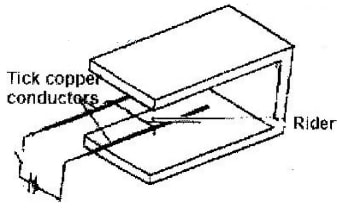
- The figure below shows the poles of two magnets close together.
Sketch the magnetic field pattern in the space between the poles. (2 marks) - The figure below shows a horse- Shoe magnet whose poles are labeled and two other magnets near it. Iron nails are attracted to the lower ends of the magnets as shown.
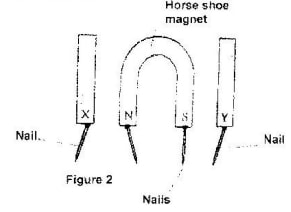
Identify the poles marked X and Y. (2 marks) - Sketch the electrostatic field pattern due to the arrangement of the charges shown in figure below (1 mark)
- Three magnets were brought near 3 pieces of material steel, soft from iron and aluminum as shown in the figure below. Indicate the magnetic field in each diagram.
- The figure shows the circular path followed by an electric beam in a magnetic field.
- A force acts on the electrons as they follow this circular path. Show on the diagram the direction of that force.
- Draw on the diagram the direction of the magnetic field responsible for the deflection of the electrons.
- Draw the magnetic field pattern in the diagram below and indicate the direction of the forces acting on the conductors.

- The force of a conductor carrying a current in a magnetic field can be varied by changing among others, the magnitude of the current and the magnetic field strength. Name two other factors that can be changed to vary the force.
- The figure below shows a soft iron ring placed between poles of two magnets.

Sketch the magnetic field pattern - Four bars of metal A, B, C and D are tested for magnetism. B attracts both A and C but not D. D does not attract A, B or C. A and C sometime attract one another and sometimes repel one another. What conclusion can you draw about?
- Bar A
- Bar B
- Bar D
- The figure below shows an incomplete circuit of an electromagnet. Complete the circuit between X and Y by drawing the windings on the two arms of the core such that A and B are both North poles when the switch S is closed. Indicate the direction of the current on the windings drawn.
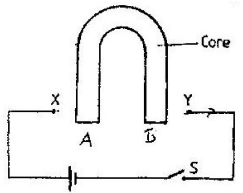
-
- State TWO factors that affect the strength of an electromagnet.
- In the set up in figure 9, the suspended meter rule is in equilibrium balanced by the magnet and the weight shown. The iron core is fixed to the bench.
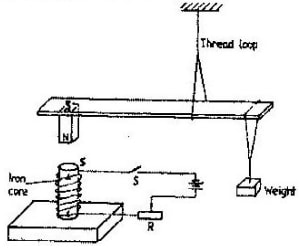
- State and explain the effect on the meter rule when the switch S is closed
- What would be the effect of reversing the battery terminals
- Suggest how the set up can be adapted to measure the current flowing in the circuit.
-
- In an experiment to determine the strength of an electromagnet, the weight of pins that can be supported by the electromagnet, was recorded against the number of turns. The current was kept constant throughout the experiment. The table shows the data obtained.
Number of turn, n
0
4
8
12
16
20
24
28
32
36
Weight, W, of pins x 10-3 (N)
0
4
14
30
58
108
198
264
296
300
- Plot a graph of weight, W, y- axis against the number of turns, n
- Use the domain theory to explain the nature of the curve.
- Sketch on the same axes, the curve that would be obtained using a higher current.
- Using a labeled diagram, explain the working of a simple relay.
- In an experiment to determine the strength of an electromagnet, the weight of pins that can be supported by the electromagnet, was recorded against the number of turns. The current was kept constant throughout the experiment. The table shows the data obtained.
Answers
- When the current increases the domains align themselves more until all of them are the same perfectly lightened direction (magnetic saturation). The magnetic force of attraction becomes constant.
-
- Wire curves/ jacks upwards according to Fleming’s Left Hand Thumb Rule.
- Suspend each of them in the earth’s magnetic field. Change their rest position and record the final direction in which key will rest. Repeat this procedure several times and record the directions. Do this experiment on each of the rods. It is noted that, the magnetized rod will rest in the earths North-south direction each time it is disturbed. The unmagnetised rod rests in random directions.
- The a.c magnetises the magnet alternately in the opposite directions 50 times in one second. When withdrawn slowly, different parts attain random polarities.
- It gains and loses magnetism easily. It is only magnetized if there is a magnetic field around it and looses its magnetism immediately the field is withdrawn. It also requires very little energy to magnetise and demagnetise.
- In fields the lines are parallel and the force acting on a small magnet/conductor is uniform. The opposite is the case for the non-uniform field.
- - Increasing current by decreasing resistance
- Turning wire AB to an angle of 900
- Increasing number of cells. - - Amount of current
- Strength of magnetic field
- Angle between magnetic field and direction of conductor. - Attraction can be between opposite poles or a magnet and a non-magnetized magnetic material.
-
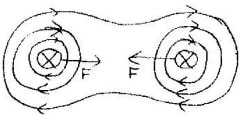
-
- i) and ii)
Suspend each of them in the earth’s magnetic field. Change their rest position and record the final direction in which key will rest. Repeat this procedure several times and record the directions. Do this experiment on each of the rods. It is noted that, the magnetized rod will rest in the earth North-south direction each time if is disturbed. The unmagnetised rod rests in random directions. - When magnetizing current is increased, the dipoles align more and more until magnetic saturation is attained where the magnetization becomes maximum and remains constant. Substance P requires less current than Q to attain saturation. This means that P is easily magnetized and also easily demagnetise- than Q. This also means that P can form temporary magnet while Q can for permanent magnet P is soft and Q is hard magnetic materials.
- i) and ii)
- Soft magnetic material is more easily magnetized and demagnetised compared to hard ones. Soft ones form temporary magnets while hard ones form permanent magnets.
- Vibration energy helps to turn the dipoles since they are in constant repulsion from dipoles contained in adjacent domains.
- By using iron powder; more of it is attracted to the poles than at the sides.
- Upwards
- By making the magnetic ends to be removed and create complete loops which reduce the repulsion of the dipoles in different domains which cause them to turn sideways.
-
-
- Rider rolls inwards i.e. into the U-shaped magnet.
-
- x is north Y is North both correct
-
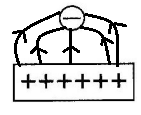
Join our whatsapp group for latest updates
Tap Here to Download for 50/-
Get on WhatsApp for 50/-
Download Magnetism Questions and Answers - Physics Form 2 Topical Revision.
Tap Here to Download for 50/-
Get on WhatsApp for 50/-
Why download?
- ✔ To read offline at any time.
- ✔ To Print at your convenience
- ✔ Share Easily with Friends / Students



